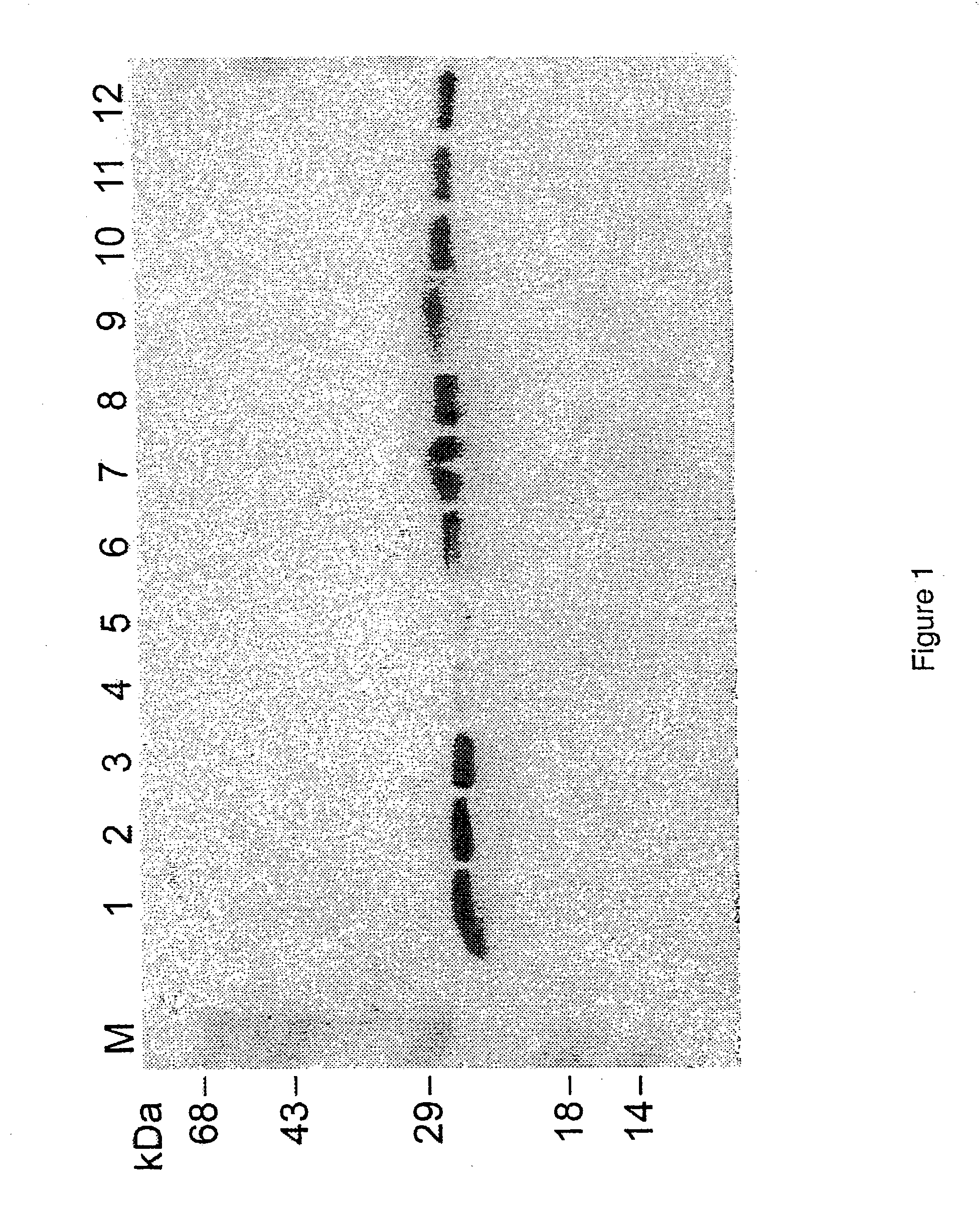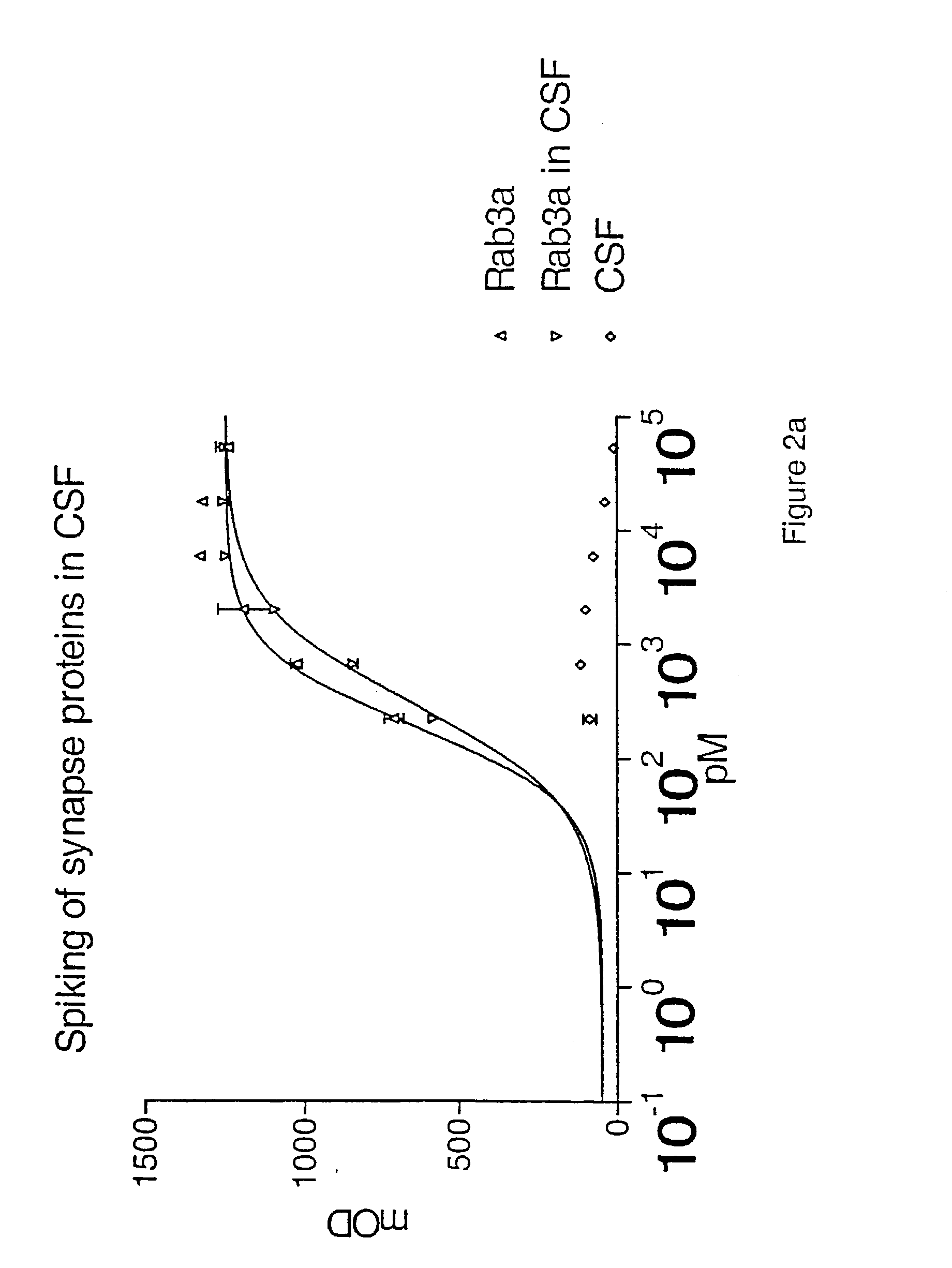Differential diagnosis of neurodegeneration
a neurodegeneration and differential diagnosis technology, applied in the field of differential diagnosis of neurodegeneration, can solve the problems of poor school performance, memory loss, growth retardation, economic loss, etc., and achieve the effect of specific detection, quantification and/or differential diagnosis
- Summary
- Abstract
- Description
- Claims
- Application Information
AI Technical Summary
Benefits of technology
Problems solved by technology
Method used
Image
Examples
example 1
Detection of Rab3a and SNAP25 in CSF
[0231] 1.1 Cloning of Rab3a and SNAP25
[0232] Specific primers were used to amplify the Rab3 and SNAP 25 coding sequence from the Quick-Screen.TM. human cDNA library (Clontech, Palo Alto, Calif., USA; Cat No K1003-1) with an amplification protocol provided by the manufacturer. In short: 35 cycles of 94.degree. C. for 45 sec, 60.degree. C. annealing for 45 sec and extension at 72.degree. C. for 2 min with Taq polymerase (Stratagene, Amsterdam, The Netherlands; Cat No 600131). The program was finalized with an extension of the polymerase reaction at 72.degree. C. for 7 min. Reactions were performed on a Perkin-Elmer (berlingen, Germany) DNA thermal cycler (Model 480). The sequence of the primers for amplification of Rab3a was based on the human Rab3a sequence (Zahraoui et al., 1989): ATG GCA TCG GCC ACA GAC TCG CGC TAT GGG (T.sub.m=76.degree. C.) for the ATG primer and CGCG TCTAG AGG CTC TCA GCA GGC GCA GTC CTG GTG CGG (T.sub.m=77.degree. C.) for the...
example 2
Presence and Detection of .alpha.-Synuclein in Cerebrospinal Fluid
[0245] 2.1 Evaluation of a Commercial Antibody for its Specificity for .alpha.-Synuclein
[0246] The specificity of a commercial available monoclonal antibody (Transduction Labs, Lexington, Ky., USA; Cat. No. S63320, IgG1) on the different synuclein isoforms was evaluated. .alpha.-synuclein, .beta.-synuclein and .gamma.-synuclein open reading frames (from ATG to stop codon) were amplified from a human brain cDNA library (HL5018; Clontech, Palo Alto, Calif., USA) using primers based on published sequence data (.alpha.-synuclein: accession number L08850; .beta.-synuclein: accession number S69965; .gamma.-synuclein: accession number AF010126). As reported, there were some important amino acid changes in the .gamma.-synuclein's original sequence: K12E and K68E and the polymorphism of amino acid 109 in this clone is E109V. The insert was subcloned in a PL-based expression system (ICCG 3307; Innogenetics, Gent, Belgium) addin...
example 3
Detection of other Neurological Markers in Cerebrospinal Fluid
[0259] 3.1 Tau and Phospho-Tau
[0260] Total tau was measured with the tau antigen test, using AT120 as capturing antibody and biotinylated HT7-BT2 as detector antibody (INNOTEST hTau antigen, Innogenetics, Gent, Belgium). Monoclonal antibody AT120 reacts equally well with both normal and hyperphosphorylated human tau protein (Vandermeeren et al., 1993), monoclonal antibody HT7 also reacts equally well with both normal and hyperphosphorylated human tau protein, while monoclonal antibody BT2 preferentially recognizes normal tau (Goedert et al., 1994). Affinity purified tau protein, prepared as described previously (Mercken et al., 1992b), was used as standard.
[0261] Phospho-tau was measured with a sandwich ELISA, using as HT7 as capturing antibody and biotinylated AT270 as detector antibody (INNOTEST phospho-tau(181), Innogenetics, Gent, Belgium). AT270 specifically recognizes phospho-tau (International application published...
PUM
| Property | Measurement | Unit |
|---|---|---|
| pH | aaaaa | aaaaa |
| concentration | aaaaa | aaaaa |
| pH | aaaaa | aaaaa |
Abstract
Description
Claims
Application Information
 Login to View More
Login to View More - R&D
- Intellectual Property
- Life Sciences
- Materials
- Tech Scout
- Unparalleled Data Quality
- Higher Quality Content
- 60% Fewer Hallucinations
Browse by: Latest US Patents, China's latest patents, Technical Efficacy Thesaurus, Application Domain, Technology Topic, Popular Technical Reports.
© 2025 PatSnap. All rights reserved.Legal|Privacy policy|Modern Slavery Act Transparency Statement|Sitemap|About US| Contact US: help@patsnap.com



